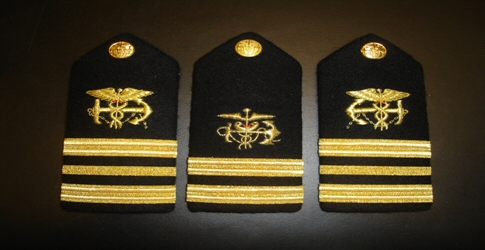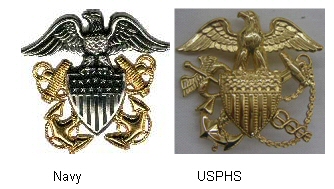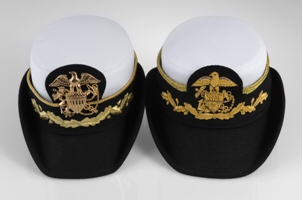
| Commissioned Corps of the U.S. Public Health Service (Corps) Uniforms | |
|
Submitted by LCDR Kyle Lyons, USPHS, Uniform Policy Coordinator, Workforce Policy and Plans Division, Office of Commissioned Corps Force Management Please note: Any uniform questions can be sent electronically to LCDR Lyons at james.lyons@hhs.gov or 240-453-6098 |
|
|
Over the past 2 years, the Office of Commissioned Corps Force Management (OCCFM) and the Office of Commissioned Corps Operations (OCCO) have worked closely with the Army Institute of Heraldry (IOH) and the Navy Clothing and Textile Research Facility (NCTRF) to make official military specifications (MilSpec) of several Corps specific uniform items. Once an item is MilSpec’d, an item’s design, color, approved material cannot be changed outside of preset parameters. One of the examples of MilSpec is the current gold colored Field Medical Readiness Badge (FMRB). Before the MilSpec, there were two metal versions -- an authorized pewter finish, and an unauthorized shiny silver version. With the MilSpec, the FMRB is now gold colored with a matching miniature version. The design on the FMRB cannot change nor can the sizes without prior approval to the original MilSpec through IOH. As efforts continue to improve the appearance and keeping with the highest of military and heraldic standards, a new MilSpec version of the shoulder boards and shoulder marks (“soft boards”) have been created. The current versions are still authorized, but as officers get promoted or replace worn or damaged shoulder boards or marks, officers will notice a significant change in the craftsmanship and detail in the replacements.
The shoulder mark on the left, and in the center, show the new MilSpec’d Anchor and Caduceus. The shoulder mark on the right and to the far right is the current version without the MilSpec. When devices or insignia are not MilSpec’d, manufacturers can ‘cut corners’ and morph them into ‘cheaper’ and less appealing versions at will and with virtually no say-so from the concerned Service.
The shoulder boards on the left and right show the new MilSpec’d Anchor and Caduceus. The shoulder board in the center is the current version without the MilSpec.
One last item. When posting pictures of officers to official Corps Web sites or publications, please check the uniform regulations or seek clarification if in doubt to be sure the officers are wearing the uniform correctly. Attention to detail both in your own personal appearance and the appearance of fellow officers brings credit to the officer(s) and the Commissioned Corps of the U.S. Public Health Service. Items such as improperly displayed awards, unauthorized ribbons, trouser length, improper insignia placement, skewed gig-lines and other seemingly small issues can become big issues when officers do not adhere to the uniform regulations/standards. |
|
|
Questions and Answers Q: What is wrong with this ribbon rack (aside from spacing due to graphics)?
Aside from gold, silver and bronze service/award stars, there are oak leaves, numbers, letters and other attachments that other uniformed services utilize to signify multiple awards or specific types of awards. In the other services, multiple awards of the same item are annotated differently on the award citation, such as “a bronze star in lieu of second award” instead of issuing another certificate with the same annotation as the first. A note of clarification, bronze or silver service/award stars are not the same as the Bronze or Silver Star medals/ribbons. Q: Is the embroidered hat badge for the Combination Cover still authorized?
A: No. The embroidered combination cover Cap Device came about during WWII, as a means of saving metal for the war effort. This then bled over for a short time during the Korean War. There is still a commercial vendor or two that still sells this item, but it is no longer authorized as an official uniform item. CCI CC26.3.6, “Insignia and Devices,” signed 1 March 2009 no longer authorizes “embroidered or hand sewn cap devices” http://dcp.psc.gov/eccis/documents/CCPM26_3_6.pdf |
|
|




